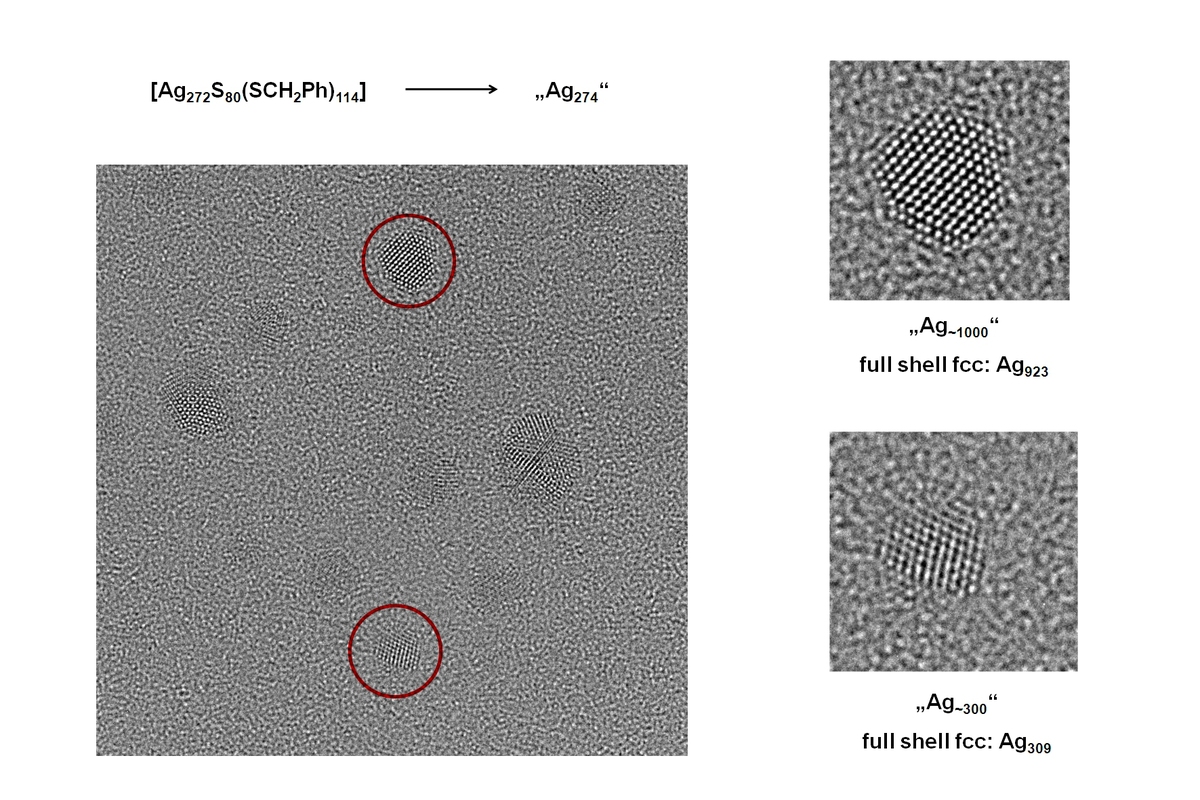C1.1: Synthesis Properties and Structural Characterization of New Nano-Scale Transition Element Clusters
Subproject Leader: Dieter Fenske
Institut für Nanotechnologie, KIT
Contributing Scientists:
Present: Wen Yu
Past: Claudia Persau, Benjamin Reiser, Robert Langer
How do Clusters Grow?
Subproject C1.1 focuses on the synthesis and structural characterization of nano-sized clusters.
Clusters are aggregates of atoms, ions or molecules that can act as intermediates during the formation of condensed phases. It is possible that these compounds are formed during the synthesis of crystalline phases from homogenous solutions but so far there is no clear evidence for this assumption. During reactions of transition metal halides with sulfides, metal chalcogenides precipitate which are extremely insoluble. In the presence of protecting ligands, however, it is possible to capture intermediates that are protected by the ligands preventing them from forming the more stable binary phase. One example are the CdS nanoclusters formed during the reaction of cadmium salts with S(SiMe3)2 in the presence of trioctylphosphane oxide[1]. By applying this technique, a broad range of particle sizes will result. For further applications it would be interesting to synthesize isostructured particles of equal size. In many transition metal chalcogenides and transition metal pnictides this can be obtained by reacting the metal halides or metal carboxylates in organic solvents with E(SiMe3)2 (E = S, Se, Te) or E(SiMe3)3 (E = P, As, Sb, Bi). To prevent the formation of extremely insoluble binary phases these reactions must be performed in the presence of tertiary phosphanes [2]. In this case we obtain polynuclear metal clusters that are protected by the tertiary phosphanes. Depending on the reaction conditions a variety of differently sized polynuclear clusters can be obtained that crystallize under certain conditions. These crystals consist of nanoscopic cluster molecules containing up to hundreds of metal atoms [3]. Recently, this synthesis technique resulted in high yields where coinage clusters of the elements Cu, Ag and Au [4, 5] were involved. The diameter of these molecules is up to 5 nm, and the properties of these compounds strongly depend on their size and structure. This size effect is due to the size dependence of the HOMO LUMO gap. In particular the optical properties of the cluster molecules are significantly influenced by this effect. Examples of such compounds are the spherical clusters [Ag168S66(StC5H11)36(PP)6] and [Ag274S80(SHH2Ph)114] shown in Fig. 1. The area marked in red in the structure of the left compound is region where the Ag atoms are disordered. In contrast, the outer shell is perfectly ordered. Apparently the cluster recalls a property of solid Ag2S in which the Ag ions are also disordered yielding a ionic conductivity. In principle, these relationships can also be described as a core in which the Ag and S atoms take a similar state as in the molten state. This core is about 10% of the total volume and is surrounded by a symmetrical shell
Are Clusters Intermediates in the Formation of Nanoparticles
Due to these properties these clusters can be described as thermodynamically unstable molecules; however at relatively mild temperatures they can decompose to the binary phases. From the above molecules we can obtain Ag2S particles in the nanometer range. These particles are metastable and, with increasing temperatures, transform to the thermodynamically more stable phases. A comparison of the molecular structures with the structures of the binary phases shows that these clusters are unusual sections of the solid phases. Clusters in the sub-nanometer range show bonding situations known from polynuclear metal complexes. In contrast hereto, in clusters containing hundreds of metal atoms an increasing tendency towards the structural properties of the binary phase is observed. At higher temperatures, these clusters are decomposed with simultaneous formation of silver. If this decomposition is performed in high dilution, particles will result in which the number of atoms corresponds to the number of atoms of the starting compound. Thus, a possible access to silver clusters is found where the number of metal atoms does not follow the rules of the magic number of atoms in stable clusters [5]. An example for an Ag cluster synthesized by this technique from [Ag274S80(SCH2Ph)114] is displayed in the TEM micrograph in Fig. 2.
Obviously the isolation of the above-described molecular cluster allows a closer study of the formation pathway of ionic crystals. Moreover, an access to tailor-made adjustment of material properties could be created.
References
|
[1] |
Choi, C.L. and Alivisatos, A.P.,Annu. Rev. Phys. Chem., 2010, 61 (7), pp 369-389, A. L. Rogach, D. V. Talapin, H. Weller,Semiconductor Nanoparticles in: Colloids and Colloidal Interfaces, Hrsg.: F. Caruso, Wiley VCH |
|
[2] |
J. F. Corrigan, O. Fuhr, D. Fenske , Adv. Mat. 2009, 21, 1867 |
|
[3] |
S. Dehnen, A. Eichhöfer, J. F. Corrigan, and D. Fenske, In: Nanoparticles: From Theory to Application. Ed. By Günter Schmid, 2004, Wiley-VCH-Verlag GmbH & Co. KgaA, Weinheim |
|
[4] |
M. L. Fu, I. Issac, D. Fenske, O. Fuhr, Angew. Chem. 2010, 122, 7052 |
|
[5] |
C. Anson, A. Eichhöfer, I. Issac, D. Fenske, O. Fuhr, P. Sevillano, C. Persau, D. Stalke, J. Zhang, Angew. Chem. Int. Ed. Engl. 2008, 47, 1326 |
List of Publications 2006-2011 as PDF
Subproject Report 2006-2010 as PDF

